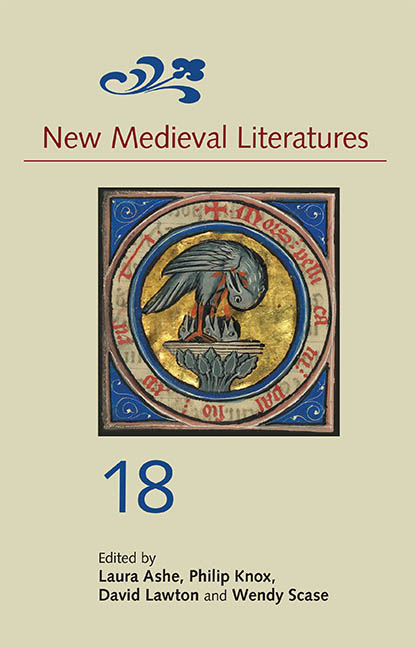Book contents
- Frontmatter
- Contents
- List of Illustrations
- List of Abbreviations
- 1 Arachnophobia and Early English Literature
- 2 Demonic Daydreams: Mind-Wandering and Mental Imagery in the Medieval Hagiography of St Dunstan
- 3 The Songs of Godric of Finchale: Vernacular Liturgy and Literary History
- 4 Sympathy for the Demon: Affective Instruction in the Katherine Group
- 5 Peynte it with Aves: Langland's Hawks, covetise, and Hugh of Fouilloy's Aviarium
- 6 Similes We Cure By: The Poetics of Late Medieval Medical Texts
- 7 The Life of Job: Bible Translation, Poem or Play?
5 - Peynte it with Aves: Langland's Hawks, covetise, and Hugh of Fouilloy's Aviarium
Published online by Cambridge University Press: 03 July 2019
- Frontmatter
- Contents
- List of Illustrations
- List of Abbreviations
- 1 Arachnophobia and Early English Literature
- 2 Demonic Daydreams: Mind-Wandering and Mental Imagery in the Medieval Hagiography of St Dunstan
- 3 The Songs of Godric of Finchale: Vernacular Liturgy and Literary History
- 4 Sympathy for the Demon: Affective Instruction in the Katherine Group
- 5 Peynte it with Aves: Langland's Hawks, covetise, and Hugh of Fouilloy's Aviarium
- 6 Similes We Cure By: The Poetics of Late Medieval Medical Texts
- 7 The Life of Job: Bible Translation, Poem or Play?
Summary
No man may serue to two lordis […]. Ȝe mown nat serue to God and richessis. Therfore Y say to ȝou, that Ȝe ben nat besie [Ne solliciti sitis] to ȝoure lijf, what Ȝe shulen ete; othir to ȝoure body, with what Ȝe shuln be clothid. […] Beholde ȝe the fleeȜinge foulis of the eir, for thei sowen nat, ne repyn, neither gadren in to bernys; and Ȝoure fadir of heuen fedith hem. […] Therfore seke ȝee first the kyngdam of God and his riȜtwisnesse, and alle these thingis shulen be cast to ȝou. (Matt. 6.24–6, 33)
The landscape of Piers Plowman teems with ‘fleynge foweles’ (8.54). This essay argues that the hawk Langland could have seen circling high over feeld and wildernesse makes repeated appearances in different guises, and that its literary origins almost certainly lie in Hugh of Fouilloy's Aviarium. Depicting ‘uita actiua’ with the emblem of the hawk in its prologue miniature (Figure 5.1), the iconography alone of the Aviarium allows us to see at the outset how Langland could have accessed such imagery for his ‘Activa Vita’, Haukyn, whose name has long puzzled critics but whose cote is also his ‘plumage’. Hugh's text illuminates in less obvious ways; once we understand his hawk, fresh interpretations of other vexed areas of our poem are released. After a brief look at the Aviarium, I discuss Haukyn and the nature of hawks from their names, before analysing the poet's presentation of Mede, the Deadly Sins (Envy, Covetise and Sleuthe), and Piers/Perkyn. I then turn to Haukyn himself before drawing my conclusions. The aim is to trace a constellation of hawks by identifying each, and clarifying the relation of one to another; and to sharpen our appreciation of Langland's resources – learning, wit, imagination, compassion, humour – in using hawks, and birds in general, to articulate a major line of argument which involves seeing pardons as lures or traps. In revising his B text (perhaps incompletely) Langland removed Piers's tearing of the pardon, Haukyn's name and many associated hawking terms, and two citations of ‘Ne soliciti sitis’ marking their parallel conversions, and I suggest some reasons for why he did so.
- Type
- Chapter
- Information
- New Medieval Literatures 18 , pp. 131 - 182Publisher: Boydell & BrewerPrint publication year: 2018



